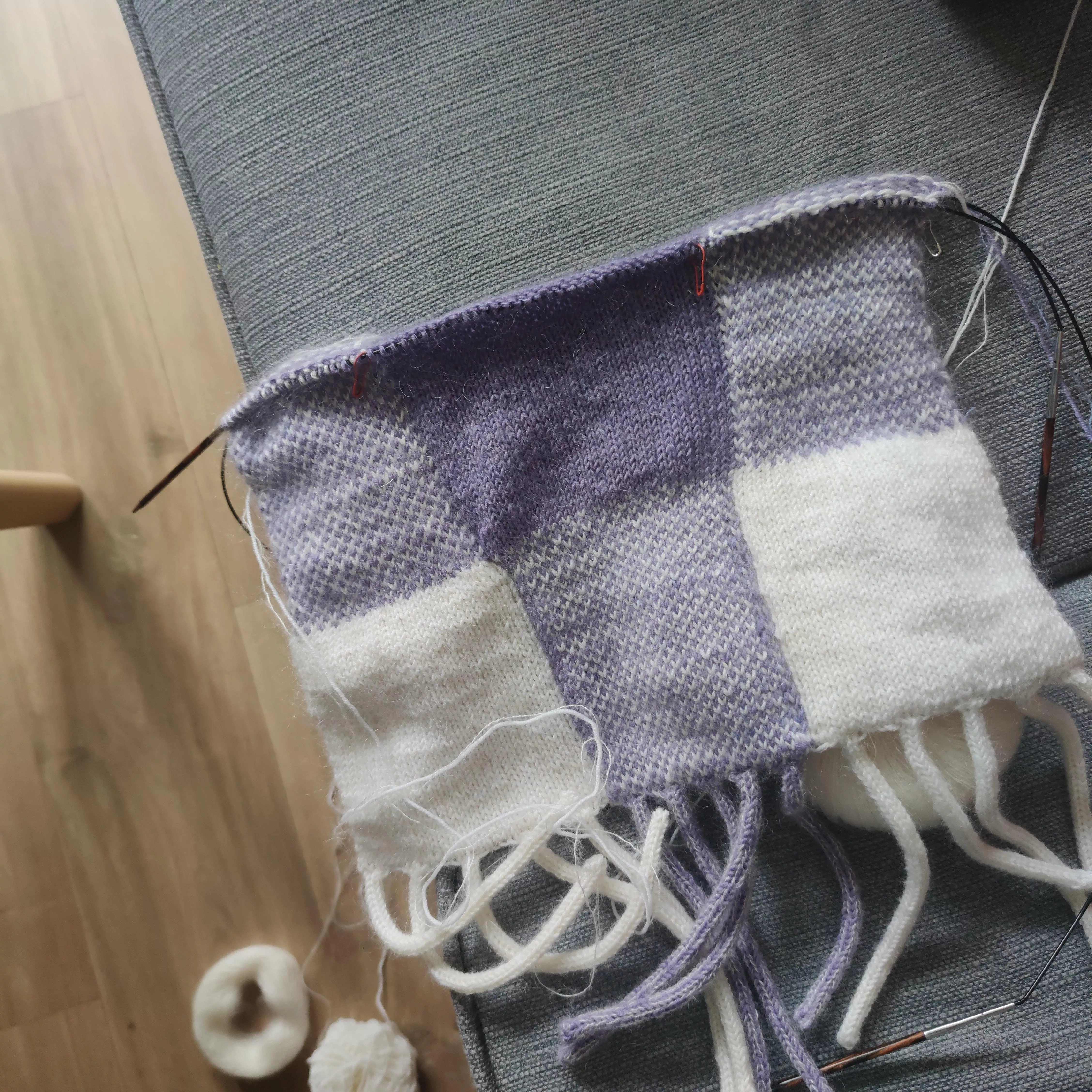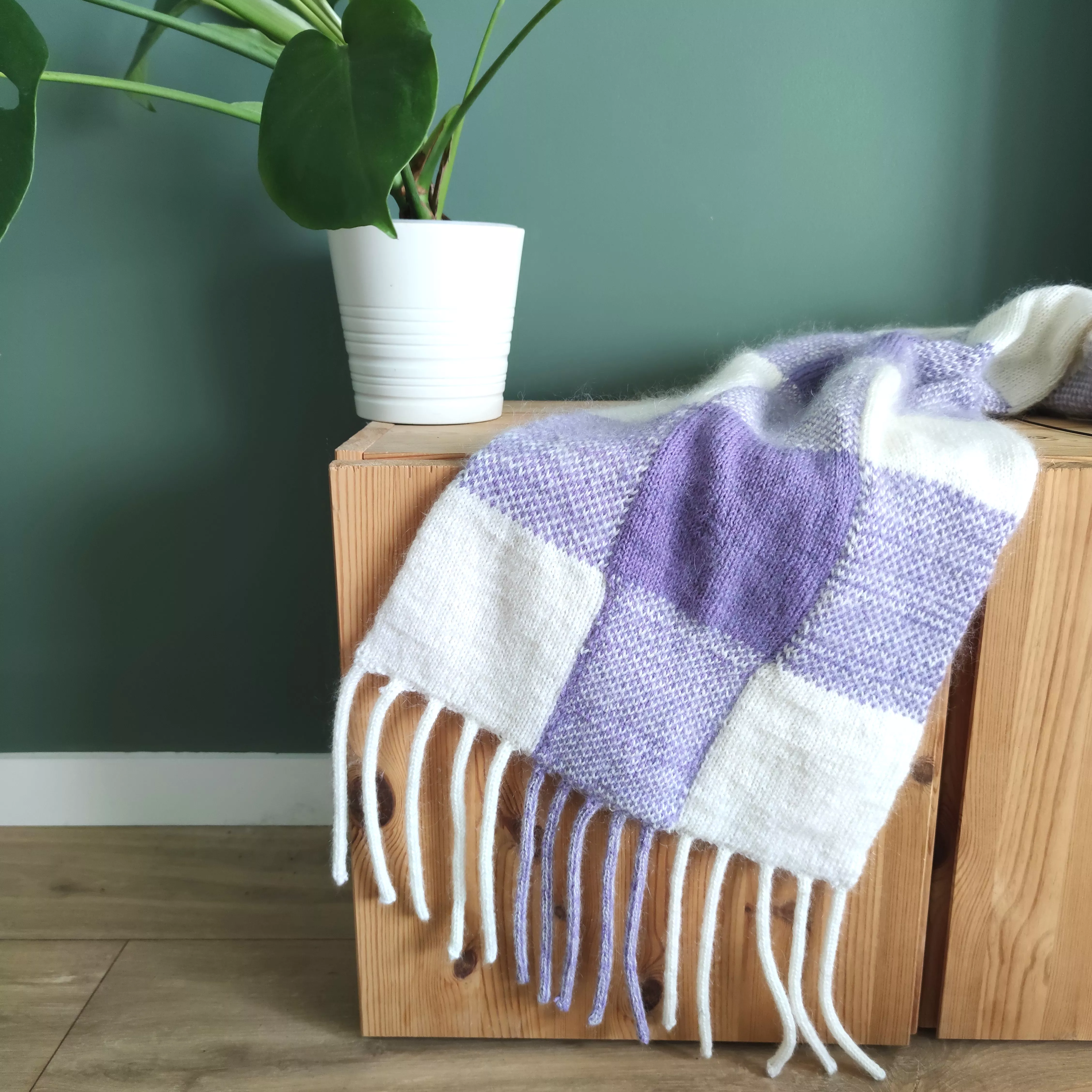The Idea
I love creating pieces that play with contrasts: classic shapes/bright colors, casual style/elegant material...
I find it's a great way to rework classic pieces and give them a real touch of modernity. It truly contributes to my mission of bringing contemporary flair to handmade knitting and inspiring people of all ages to try out this wonderful creative activity.
The Inspiration
For a while now, I've had in mind to create a lovely tartan scarf with pastel colors.The "Cosy Clan" cover pattern served as a trial run for this concept.
However, the challenge with working in jacquard is that the front side looks beautiful, but the back side is much less appealing.
Now, the complexity of a scarf lies in the fact that there's no right or wrong side; both sides need to be visible and attractive.So, on paper, jacquard and scarves seem incompatible...
I pondered over this issue to find my own solution. I thought the best option would be to knit with double thickness. This way, if the two layers are sewn or joined on the sides, there's no risk of an unsightly interior. However, the downside is that it adds bulk, potentially making the textile rigid.
Despite this drawback, I found the solution to be very promising. By knitting with a soft yarn and using sufficiently large needles, it was possible to maintain flexibility. A few tests were all it took to calibrate it just right.
The second challenge was integrating fringes into the design. Often, tartan scarves feature fringes made from twisted warp threads. Replicating this look and seamlessly attaching the fringes to the scarf was crucial.
After careful consideration, the best solution I found was to create cords gathered together to form the cast-on row.
With the main challenges resolved, I could finally embark on creating my first reversible tartan scarf with fringes!
For your information, despite these explanations, I know the casting-on method might not be the most common. So, to assist you in getting started, I've created a tutorial video on my YouTube channel:
The Pattern
The model is knitted in the round from bottom to top. It is created from 15 corded strands made with a knitting spool, connected together by a cast-on row and 15 others connected to the bind-off row. The central part is knitted in the round using jacquard technique on two different circular needles: the first one for the front and the second for the back.
Material: I made the model shown in the photo using 2 different colors, each composed of two strands knitted together: one strand of white baby merino, one strand of white mohair, one strand of purple baby merino, and one strand of purple mohair. I used approximately 1600 meters or 1750 inches of white merino and mohair, and about 1400 meters or 1431 inches for the purple. For substitutions, I recommend choosing a soft main material like alpaca to avoid a too rigid finish and a "cuddly" secondary yarn.
Needles: Circular and double-pointed needles 4mm/US6 or equivalent to achieve the correct gauge.
Other: Optional knitting spool.
Gauge 10x10cm or 4x4in: 21 stitches x 30 rows.
Finished size: The model is one size and measures approximately 42cm or 16.5in wide and is 1.54m or 1.7 yards long without the cords and 1.88m or 2 yards with the cords.
The Pattern
Don't forget, if you're having difficulties, the pattern is available as a video tutorial on my YouTube channel Terrifiknits!
Please note, exceptionally for this project, I recommend weaving in the ends as you go along, as they will become increasingly difficult to access as you progress.
- Create 10 white cords and 5 purple ones, each consisting of 4 stitches and 17cm or 6.7in in height, using a knitting spool or double-pointed needles size 4mm/US6.
- Set them aside one by one on a circular needle: one stitch, its corresponding stitch, the next stitch after the first, and its corresponding stitch. The order to follow is 5 white cords, 5 purple cords, and then 5 white cords.
- Start the cast-on:
- A total of 88 stitches have been cast on, with 29 stitches in white, 30 stitches in purple, and 29 stitches in white.
- With a crochet hook, pick up 29 stitches in white, 30 stitches alternating 1 white/1 purple, 29 stitches in white, and place them on the second circular needle 4mm/US6 = 88 stitches
- *Continue by knitting on the first circular needle 29 stitches in white, 30 stitches alternating 1 purple/1 white, 29 stitches in white, switch to the other needle, 29 stitches in white, 30 stitches alternating 1 purple/1 white, 29 stitches in white.
- Continue like this for 14cm or 5.5in in height from the cast-on stitches (approximately 40 rounds), making sure to work the white/purple alternations staggered (a white stitch is knitted in purple on the next round).
- On the next round, replace the section knitted in white with an alternating white/purple and the white/purple section with a completely purple zone.
- Continue like this for 28cm or 11in from the cast-on stitches (we're at 14cm or 5.5in from the end of the scarf) or until the desired height minus 14cm or 5.5in.
- Repeat the sequence from * to * until you reach a height of 1.4m or 1.5 yds from the cast-on stitches (you're at 14cm or 5.5in from the end of the scarf) or the desired height minus 14cm or 5.5 in.
- Work a final sequence of 14cm or 5.5in in white/white and purple/white, i.e., 29 stitches in white, 30 stitches alternating 1 purple/1 white, 29 stitches in white, switch to the other needle, 29 stitches in white, 30 stitches alternating 1 purple/1 white, 29 stitches in white.
- Finish by adding the cords to the other end:
- Weave in the remaining ends.
- Note: Due to the jacquard on the two-tone sections (white/purple), there may be differences in material density between these areas and those made with a single color. Precise blocking is essential to even out these differences.
- With a white yarn, knit the first 4 stitches of the first white cord with the 4mm needle,
- Cast on 2 stitches,
- Knit the second white cord,
- Cast on 2 stitches,
- Knit the third white cord,
- Cast on 2 stitches,
- Knit the fourth white cord,
- Cast on 2 stitches,
- Knit the fifth white cord,
- Cast on 1 stitch,
- Switch to purple, cast on 1 stitch,
- Knit the first purple cord,
- Cast on 2 stitches,
- Knit the second purple cord,
- Cast on 2 stitches,
- Knit the third purple cord,
- Cast on 2 stitches,
- Knit the fourth purple cord,
- Cast on 2 stitches,
- Knit the fifth purple cord,
- Cast on 1 stitch,
- Switch to white, cast on 1 stitch,
- Knit the sixth white cord,
- Cast on 2 stitches,
- Knit the seventh white cord,
- Cast on 2 stitches,
- Knit the eighth white cord,
- Cast on 2 stitches,
- Knit the ninth white cord,
- Cast on 2 stitches,
- Knit the tenth white cord
- Option 1, if you are working with a knitting spool: :
- Create 10 white cords and 5 purple ones, each consisting of 4 stitches and 17cm or 6.7in in height.
- Sew the first cord with the first stitches of the scarf: sew the first stitch of the cord with the first stitch of the first circular needle and the first stitch of the second circular needle.
- Proceed with the next 4 stitches of the cord.
- Bind off together the fifth stitch of the first circular needle and the fifth stitch of the second circular needle.
- Repeat for the sixth stitches on both needles.
- Continue until you have sewn all the cords and bound off all the stitches.
- Option 2, if you don't have a knitting spool::
- Knit together the first stitch of the first circular needle and the first stitch of the second circular needle.
- Do the same for the next three stitches.
- Bind off together the fifth stitch of the first circular needle and the fifth stitch of the second circular needle. Repeat for the sixth stitches.
- Continue like this until you have prepared the base for all the cords and bound off all the stitches in between. You should have only the 60 stitches remaining, which, taken in groups of 4, will be used to create the cords.
- Take the first set of 4 stitches and knit them into a cord for 17cm or 6.7in.
- Repeat this process for the remaining 15 cords.
And there you have it, a superb homemade tartan scarf!
Perfect for keeping you warm in style!
Don't forget to tag me on Instagram, Facebook, or TikTok with the hashtags #terrifiknits and #Thornhillscarf or #EcharpeThornhill once you've finished, or add this project to your Ravelry list! I can't wait to see your version!
What you'll need :
Knitting pattern: download the instructions by clicking on the button bellow
Thornhill Scarf Terrifiknits (PDF, 476.52 KB)
All my patterns are available for free.
So dont forget to show your support by subscribing to any of my social medias !
You'll help increase the visibility of my work...
You're document will be available in
Your file is availableDownload
Yarn used : Baby merino and Kidsilk, color Natural and Light Lavander (uni color 01, 25 et 17), Drops
https://www.garnstudio.com/yarn.php?show=drops-brushed-alpaca-silk&cid=8
https://www.garnstudio.com/yarn.php?show=drops-baby-merino&cid=8





Love your patterns and love knitting
Thank you so much ! Knitting is the best ;)
Answer
Add a comment